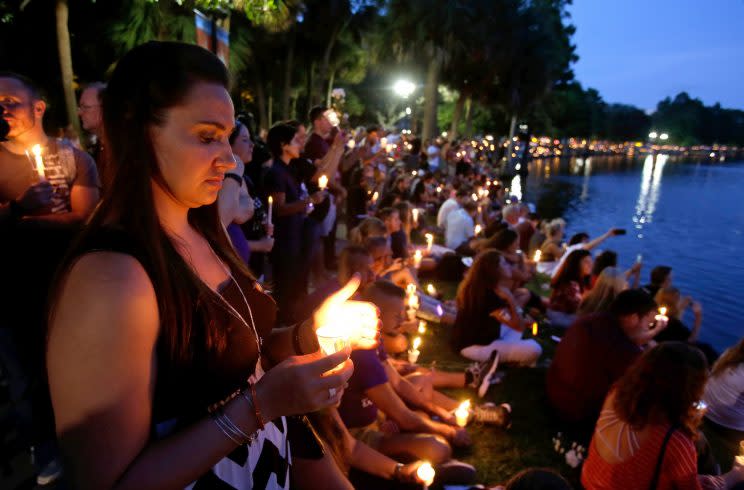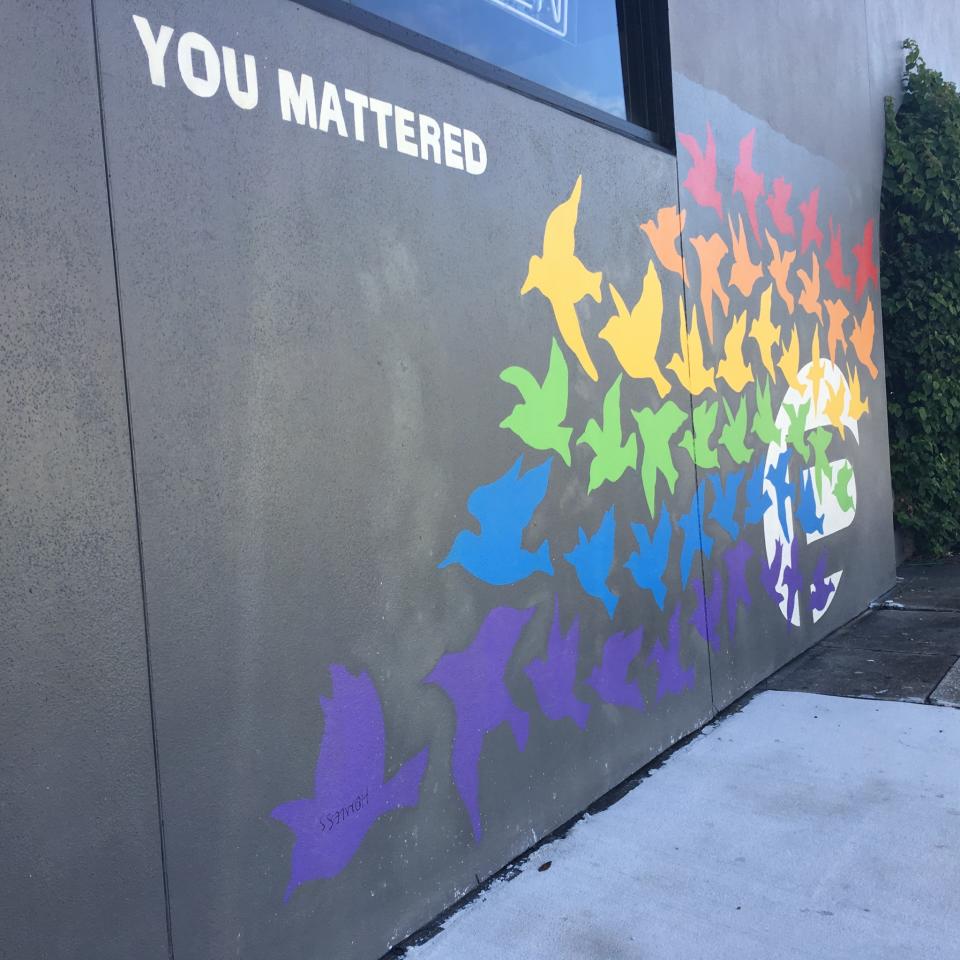Orlando businesses are building a better future four months after Pulse nightclub shooting

On a recent weekend morning the path around Lake Eola Park was bustling. Days later, Hurricane Matthew would lash Orlando; however, in this sunny moment, residents walking their dogs deftly navigated their pooches away from white swans and black swans and shared the footpath with sculpted, sweaty joggers. At the amphitheatre workers were setting up for a family-friendly afternoon event: “Dance Out Bullying!” And at the Sunday farmer’s market, vendors offered sweet kettle corn and homemade bread to passersby.
The park has long been considered the heart of the city and in June it was the site of several candlelight vigils in memory of the 49 people killed and 53 injured at Pulse nightclub. At one vigil, 50,000 Central Floridians flocked to the park and, amidst the cypress, eucalyptus and palm trees that encircle the lake, chanted “One Orlando United” and “We Remember”.
For anyone watching the scene on the news, the gathering was moving and revelatory: we witnessed the endearing grit of a city and its residents united in mourning in a beautiful setting that tends to be overshadowed by theme parks.
It’s no secret that tourists throng to Central Florida and enjoy the buoyant atmosphere of Disney World, Universal and Legoland. Last year Orlando was America’s most-visited city as 66 million tourists from around the planet made a pilgrimage there. Canada remains Orlando’s top international market, with more than one million of us northerners heading down annually and four million to Florida overall.
But Orlando, it turns out, tells a tale of two cities: theme parks as well as culturally vibrant neighbourhoods.
From mega-developments to evolution of main streets
Drive 30 minutes northeast of the theme parks and you reach one of those areas, the Audubon Park Garden District (APGD), a shopping and dining area packed with thriving, local small businesses.
“My colleagues and I talk a lot about tourism and really want visitors to have the best of both worlds. We hope they will be able to see how natural and beautiful Orlando is. It’s not just a bunch of bright lights and theme parks,” said Emily Rankin, owner of Local Roots, a farm store that sells locally grown fresh produce at the East End Market. “This is the real Orlando.”

On this Saturday night Rankin was luminescent, greeting guests with hugs and passing out drinks to celebrate her 36th birthday and more generally, the success of a venture — a farm-to-restaurant distribution program, which would have been unimaginable even a decade ago.
Rankin is an overachiever; one of her many hats is founder of the APGD, which this year won the Great American Main Street Award from the National Trust for Historic Preservation.
“We have a thriving food scene that is blossoming right now,” she said, introducing a visitor to Chef Matt Hinckley and gesturing to an array of Hinckley’s Fancy Meats pork products in a chilled display case. “He’s known as the ‘pigsmith,'” she laughed.
This July at the Annual Orlando Main Streets Award Ceremony, Mayor Buddy Dyer presented 30 individual and district awards to recognize volunteers, businesses, and merchants for contributing to the success of the eight districts in the Orlando Main Streets program. The economic development program has welcomed more than 730 new locally-owned businesses and created nearly 4,500 new full- and part-time jobs.
Orlando’s sport scene is also burgeoning. In April 2017, the U.S. Tennis Association will relocate from Houston to Orlando’s Lake Nona community with the opening of a new US$60-million national campus that boasts the country’s largest tennis facility with more than 100 courts.
Considering the summer began with tragedy after tragedy, these entrepreneurial developments are a reminder to visitors that Orlando is a lively, growing city, said Michael Perkins, executive director of the Orange County Regional History Center (OCRHC) in downtown Orlando.
“This is an invigorated town; it’s a community that is still on the rise and growing,” said Perkins, who moved to Orlando from Lansing, Mich. 30 years ago. Back then neighbourhoods were sprawling and not unified he said.
Coming home
Jessica Thompson was apprehensive about returning to her old neighbourhood. After attending college in Atlanta for four years she wondered if the arts and culture experiences would measure up to what she enjoyed in Atlanta. She was pleasantly surprised to see the city had expanded, with new apartments, hotels, restaurants, and retail. She fell in love with Orlando, where she was born and raised.
Thompson, Brand Experience Manager at the newly renovated B Resort & Spa, a Walt Disney World Resort hotel in Lake Buena Vista, loves that Orlando has become “a melting pot of people from different backgrounds and cultures.” She added, “You could be hanging out at a coffee shop and meet new friends from upstate New York or the Caribbean Islands.” Thompson lives in south downtown Orlando, close to Lake Eola Park, a neighbourhood she describes as vibrant.
“We have so many amazing attractions such as Disney World in our backyard,” Thompson said. “Mostly I like the weekly events at local hangouts.”
Everyone has a Pulse
A 15-minute walk from Lake Eola Park is the popular Mills50 district, the largest concentration of Chinese-American, Vietnamese-American and Korean-American restaurants in Central Florida. Banh Mi Nha Trang, for instance, tucked away in a nondescript plaza (and therefore almost impossible to find), serves outstanding Vietnamese iced coffee and 22 types of sandwiches. There are 285 glowing Yelp reviews that attest to the food’s galactic deliciousness. The restaurant seats roughly 12 people.
“More and more Floridians, hipsters, are coming here to try everything…people are discovering what the neighbourhood has to offer,” said Ricky Ly, an engineer and founder of TastyChomps.com, a food and restaurant blog.
The neighbourhood itself has evolved and grown so that there is increasing diversity and inclusivity among residents, Ly said.

“Mills Avenue has a big LGBT community so [Pulse] was shocking for everyone,” he said, describing how Orlando’s 40-year-old Vietnamese community came together after the Pulse shooting, held a candlelight vigil and prayers with Buddhist monks and Catholic priests and local residents.
Today, on the exterior brick wall of a grocery store, art honours the Pulse victims. One phrase is reprinted 14 times: Everyone has a Pulse. On a mural at the intersection of Mills Avenue and Colonial Drive, 49 doves painted in rainbow colours fly over the Pulse nightclub logo. The artwork reads: You mattered.
Summer of unity
No question, summer was difficult for the residents of the theme-park capital: on June 10, singer Christina Grimmie, a finalist on reality series The Voice, was gunned down as she signed autographs following one of her shows. June 12 was the infamous Pulse nightclub shooting. On June 14 an alligator killed a two-year-old boy visiting Disney World with his family.
Now, some four months later, quiet tributes continue as memories of the hate crime, in particular, linger, and the city marches ahead.
Staff at the Orange County Regional History Center, which is a few blocks from Lake Eola, has collected approximately 5,000 items from memorial sites. The focus is on preserving the banners, posters, balloons, artwork, handwritten notes from children, origami, flags, stuffed animals, and jewelry they pick up. Some items are warped from rain, sun damage or candle wax.
“We are building this collection because it’s part of our history,” said Perkins. And when the community is ready to look back at the event and its aftermath the OCRHC will have a collection capable of supporting the community’s needs he said.
In the meantime the City of Orlando plans to officially participate — for the first time — in the Come Out with Pride Festival, taking place at Lake Eola Park in November.
“This experience helped galvanize an already strong community,” George Aguel, president and CEO of Visit Orlando, the city’s convention and visitors’ bureau, told Yahoo Canada Finance recently. “The Pulse tragedy will always be in our memory. And we have a community that believes in our future.”
Unlike Paris and cities in Turkey, both of which experienced a drop in the number of international visitors after terror attacks, Orlando has held steady, Aguel said. He declined to share data explaining it wouldn’t be available until 2017. As for rebranding the city in order to convince tourists it’s safe to visit, Aguel said there is no marketing plan to overhaul the Orlando brand. Instead, “We have to consistently and continuously reinvent ourselves,” he said. “Our major theme parks are constantly creating new experiences and refreshing the ones that have been there to bring back folks who want to have that next-level experience.”
He cited the opening of the entertainment district on International Drive, which includes attractions like: the Orlando Eye, a 400-foot-tall Ferris Wheel with air conditioned compartments that provides views as far as Cape Canaveral; Madame Tussauds celebrity wax museum; and the new Sea Life aquarium, as examples of the city’s ongoing ability to evolve and innovate.
Amber Nasrulla was a guest of Visit Orlando and the B Resort Hotel & Spa.

 Yahoo Finance
Yahoo Finance 
